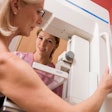Black women have less access to new mammography technology compared with white women, though these differences decrease over time as the technologies become more widely available, according to a study published October 11 in the journal Radiology.
A team led by Eric Christensen, PhD, from the American College of Radiology's Neiman Health Policy Institute looked at data from over 4 million women with Medicare. They found that differences in mammography occurred both during the transition from screen-film mammography to digital mammography and then for the transition to digital breast tomosynthesis (DBT).
"The results of our study show some disparities are transitional ... in that newer technology diffuses unevenly, but in economically predictable ways," Christensen told AuntMinnie.com.
Previous research suggests that despite the breast cancer incidence rate among Black and white women being close to equal, Black women have a 40% higher mortality rate than white women. Meanwhile, women of other races have lower incidence rates than white or Black women in similar studies.
Early detection of breast cancer through routine screening mammography is key to better outcomes. However, racial and socioeconomic disparities have persisted in breast cancer screening volumes and access, even with newer technologies such as DBT becoming ever more popular.
Christensen and colleagues wanted to explore the relationship between race and use of newer mammography technology in women receiving breast screening. They looked at a total of 4,028,696 institutional mammography claims between 2005 and 2020. In their retrospective study, the team included claims from women between the ages of 40 and 89 with Medicare fee-for-service insurance. The average age of the women was 72 years.
As measured by odds ratio, Black women were less likely to have their breast screening exams performed with more advanced mammography technology.
| Comparison in use of newer mammographic technologies among Black, white women (measured by odds ratios) | |||
| White | Black | p-values | |
| Use of digital mammography over screen-film mammography (2005) | 1 (reference) | 0.8 | < 0.001 |
| Use of DBT (2015-2020) | 1 (reference) | 0.84 | < 0.001 |
The researchers noted that the differences in using digital mammography over screen-film mammography remained until 2009.
The team also found that racial differences in digital mammography use across institutions followed a U-shaped pattern. These differences peaked at 3.8 percentage points less for Black women compared to white women in 2011 (p = 0.001). Then, it decreased to 1.2 percentage points less for Black women in 2016 (p = 0.02). This shows that as digital mammography became more universal, racial differences in access were not permanent and started to disappear.
The researchers also noted that while the transition to DBT is still underway, these percentage point differences "appear to have peaked and begun subsiding." They noted larger transitional disparities with the ongoing transition to DBT but did not investigate potential causes.
Christensen, however, said the reason may be economical. With institutions going great lengths to acquire digital mammography systems, he suggested they may be reluctant to make such a transition to DBT when there are "many years of useful life" remaining in digital mammography systems they already use.
"Unless there is a return on investment to make the transition to DBT before the digital technology has reached its effective lifecycle, institutions may hesitate transitioning," he said. "The return on investment is clearly higher for institutions that have more favorable commercial reimbursement."
The study's authors wrote that healthcare organizations have a responsibility to be equitable in care provision, which they suggested can be enhanced by reimbursement policies that help with investing in sites serving disadvantaged individuals.
"Equitable provision of breast cancer screening has the potential to improve population health and supporting health policy can propel our system closer to this goal," they wrote.
Christensen told AuntMinnie.com that the team is exploring the impact that urban settings and community income can have on mammography rates, sorted by race and ethnicity.
"In other words, mammography rates vary by where women live and by the average income of the community in which they live. Such differences are documented," he said. "What we are exploring is the degree to which these factors impact mammography rates differently by race and ethnicity."
In an accompanying editorial, Dr. Christoph Lee and Dr. Marissa Lawson from the University of Washington wrote that radiologists are in a "unique" position to improve access to newer imaging technologies by identifying and addressing factors playing parts in health disparities.
"Radiologists must demonstrate how timely access to and use of newer and advanced imaging technologies not only for screening but also during the diagnostic period, treatment decision-making period, and surveillance period can improve patient outcomes for all populations with a health equity lens," they wrote. "Future investigations should also address state-of-the-art breast imaging technology use and associated outcomes throughout the screening and diagnostic episode of care."




















